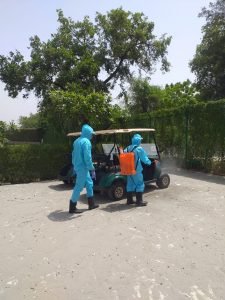
It isn’t for nothing that the Classic Golf & Country Club was declared the safest golf course in the National Capital Region during the pandemic.
Ensconced at the foothills of the Aravalli Mountain ranges in Haryana’s Mewat district, not far from the capital New Delhi, this 27-hole Jack Nicklaus signature course was a first in South Asia when it came up, and with time has maintained the exclusive tag.
Exclusive: Throwback for Manu Gandas the week of Jeev Milkha Singh Invitational
It’s not just the layout that makes the 300-acre facility unique; the work ethic of the workforce is top-notch as well. This came to the fore again with the way operations were handled after the golf course reopened following the first and second phases of lockdown in the space of a year.

There were a couple of mantras that drove the campaign to prove “golf is the safest sport in these times”, and along the way stringent steps ensured that not a single staff or club member tested positive for the virus.
Keshav Kumar, DGM (Marketing and Sales) was at the forefront of this drive. “My chief concern was if I could keep my staff safe, the members would be healthy too. It was better to take extra precautions than to regret later,” he said.
The measures pressed into action did evoke resentment from some quarters initially given the uncertain times, but there was no budging by the authorities. A lot of research went into formulating the policies as well as inputs from the parent company ITC’s COVID command centre.
Tracking a champ: Racking up numbers a norm with Viktor Hovland
Atop the to-do list was to ensure the golf course was in prime condition when members returned after the first reopening last year. A small workforce was stationed at the facility for maintenance and a quarantine centre set up nearby to test personnel on return as the situation started to ease.
Soon, it was time to throw open the gates to members. Those coming in after booking their tee-time on the club’s app were subjected to temperature checks and had to produce proof (via the Indian government’s health app Aarogya Setu) that they were safe to proceed after sanitization of their cars.

All through, the endeavour was to ensure social distancing/minimum contact. Golfers were expected to park and hop on to a cart from a designated spot and head to the clubhouse. Once at the pro shop, payments were accepted by scanning the bar code.
It was one golfer to a cart and tee times were advanced to ensure there was a 15-minute gap between groups. Members could carry food, but items they got from home. Water was available on course, placed on racks at vantage points for pickup.
After the round, golfers had to leave the cart at a designated spot for a four-stage sanitation process. This involved four personnel in PPE suits first spraying sanitizer, followed by water and air being applied at high pressure. The final stage was about fogging the vehicle and aligning it in the parking lot. The carts took a hit, especially the electricals, a result of the cleansing, but nothing could be left to chance.

Among the list of don’ts was using the spa and locker rooms, raking of bunkers and access to caddies, who were engaged as spotters during this phase. To keep a check on exposure, golf course personnel were divided into two teams and worked on alternate days.
Given the skepticism, footfall fell but the inflow was consistent, and numbers rose with time as word spread about the measures in place to ensure a safe round of golf at a course that showed the way to cope with a crisis of unprecedented proportions.
Photo credit: Classic Golf & Country Club
The article first appeared on the Asian Tour website
Making Amends: Dean Burmester takes five years to set history right




